Author(s): Ombugadu A*, Maikenti JI, Anichebe F, Okunsebor SA, Pam VA, Adejoh VA, Dawam NN, Ombugadu EO, Attah AS, Ahmed HO, Aimankhu OP, Uzoigwe NR, Kwala GJ, Dogo KS, Njila H L, Echor BO, Deme GG, Aliyu AA, Ayuba SO, Odey SA, Anyebe GE, Micah EM, Ayim JO, Benson RF, Mafuyai MJ, Nkup CD, Ashigar MA, Samuel MD, Da’an SA, Polycarp IA, Angbalaga GA, Stephen DS
One of the factors militating against fish farming in Nigeria have been lack of adequate feed that are formulated to meet the nutrient requirement of culturable fish species. To this end, the study on dietary inclusion of Citrullus lanatus (watermelon) seed in fish feed: the proximate analysis, determination of growth performance and feed utilization in Clarias gariepinus fingerlings was carried out between August and October 2019. The proximate analysis and economic viability were determined according to standard methods. The experimental diet was set up across varying proportions: 0% as the control, 15%, 20%, 25% and 36% inclusion levels respectively. The result of the proximate analysis for the experimental diets showed that diet 3 (20.00% inclusion) had the highest crude protein content; lipid level was highest in diet 4 (25% inclusion); while diet 1 (control) had the highest dry matter, ash and nitrogen free extract contents. The result of the experiment showed that 36% watermelon seed inclusion yielded the highest growth performance and feed utilization in Clarias gariepinus fingerlings. However, there was no significant difference (P > 0.05) in relation to inclusion percentages of watermelon seed on growth performance in Clarias gariepinus fingerlings. In conclusion, relatively high proportion of watermelon seed inclusion in fish feed formulation is hereby recommended in order to improve growth performance and feed utilization in Clarias gariepinus fingerlings.
Aquaculture is considered a major animal food production sector [1]. According to Orire and Ricketts, the sustainability of an aquaculture enterprise is hinged on the capability of fish farmers to effectively formulate nutritionally balanced fish feed, capable of meeting the nutritional requirements of their cultured species at a low cost [2]. Nutrient requirements differ by fish species, thus it is imperative for fish farmers to have the knowledge of the nutritional history of their preferred aquaculture species as to formulate a nutritionally balanced diets that will ensure optimal growth [3]. The major challenge faced by most fish farmers in Nigeria is the high cost of fish feed stuffs [4, 5]. According to Gabriel et al [6]. fish feed contributes between 60% and 70% to the variable cost of aquaculture. It is one of the factors that determines the profitability and viability of aquaculture production [7]. Hence it is necessary to search for cheap and locally available feed components that can serve as alternative energy feed for fish. The paradigm shift is aimed at reducing production cost without compromising feed quality [8].
Studies have shown that vegetable protein sources have high potentials for supplying fish with required protein needed for maximum productivity [9]. Watermelon (Citrullus lanatus) (family Cucurbitacea) is an oil seed that is rich in 10 essentially indispensable amino acids, it contains 30.6 crude protein, some minerals and lipids among other [10]. The use of watermelon in feed formulation is expected to provide all the indispensable amino acids required by Clarias gariepinus [11]. It is rich in protein and some minerals which are needed for osmotic regulation, maintenance of body fluids, locomotion and stability in its environment by Clarias gariepinus. The peel contains impressive concentrations of most nutrients like phenolic antioxidants, flavonoids and lycopene [12]. The peel has being reported to be a good dietary energy source in the diet of Nile tilapia [2]. Although C. lanatus peels are usually discarded as food waste, Shazali et al. reported that the inclusion of C. lanatus seed meal in broiler diets induced better growth and feed utilization efficiency. Citrullus lanatus seed peel meal has also been reported to increase growth and nutrient utilization in Cyprinus carpio and Oreochromis niloticus as reported by Lateef et al. and Oladipupo and Salami [13-15].
Clarias gariepinus is an important aquaculture fish in Africa and in Nigeria in particular, but its culture is being hampered and becoming unattractive by high cost of feeds and its scarcity [16]. Aquaculture production seems to be responding to the increased fish demand and have exclusively increased the world fish production by 20 million tons [16]. Irrespective of the achievement of aquaculture, the high cost and scarcity of desirable feeds for aquaculture enterprises in Nigeria has become a serious constraint in the successful operation of intensive aquaculture enterprise. An inexpensive source of fish feeds will make fish farming attractive due to its profitability. Research and studies into cheaper alternative protein sources for the development of least cost feeds for a small-enterprise fish farmer is an utmost priority in developing countries. To this end, the study on the investigation on the dietary inclusion of Citrullus lanatus (watermelon) seed in fish feed: proximate analysis, growth performance and feed utilization in Clarias gariepinus fingerlings was conducted.
The experiment was conducted at the Fisheries Unit of the Experimental Farm of the Department of Aquaculture and Fisheries Management of the Faculty of Agriculture, Nasarawa State University Shabu-Lafia Campus. Lafia is located on latitude 8° 35’ N and longitude 8° 32’ E, altitude 181.53 m above sea level with a mean temperature of 34 °C, relative humidity of 40-86% and average day light of 9-12 hours [17].
The study was carried between 26th August and 21st October 2019. Three hundred (300) Clarias gariepinus fingerlings were obtained from Shabu Fish Farm behind cassava factory in Lafia metropolis, Nasarawa State. The experimental fish were acclimatized to experimental condition in an outdoor concrete tank of the Departmental Fish Farm for 5 days [18].
The composition and concentration of diet for the different treatment are shown on Tables 1 and 2 which was carried out using the method described by Olurin [19]. All dietary ingredients were ground and mixed with vitamin-mineral premix and water was added gradually until a desirable paste-like consistency was obtained after which the mixture was pelletized through 2mm disc and sun-dried.
The pelletized feeds were then stored in air tight polythene bags, until required. Diet samples were subjected to proximate analysis feed formulation [19].
Diet 1 (DT1) was the control with no inclusion of Citrullus lanatus (watermelon seed cake) used during formulation, Diet 2 (DT2) contains 15% inclusion of Citrullus lanatus (watermelon seed cake), Diet 3 (DT3) contain 20% inclusion of Citrullus lanatus (watermelon seed cake), Diet 4 (DT4) contain 25% inclusion of Citrullus lanatus (watermelon seed cake) while Diet 5 (DT5) contains 36% inclusion of Citrullus lanatus (watermelon seed cake), all these inclusion at different level was added to determine different growth rate via these inclusion.
Table 1: Gross Composition of Experimental Diets| Ingredients | DT1 (0%) | DT2 (15%) | DT3 (20%) | DT4 (25%) | DT5 (36%) |
|---|---|---|---|---|---|
| Soya beans | 32 | 32 | 32 | 32 | 32 |
| Fishmeal | 14 | 14 | 14 | 14 | 14 |
| GNC | 36 | 21 | 16 | 11 | 0 |
| Watermelon seed | 0 | 15 | 20 | 25 | 36 |
| Maize | 7.5 | 7.5 | 7.5 | 7.5 | 7.5 |
| Lysine | 0.5 | 0.5 | 0.5 | 0.5 | 0.5 |
| Methionine | 0.5 | 0.5 | 0.5 | 0.5 | 0.5 |
| Vitamin | 0.5 | 0.5 | 0.5 | 0.5 | 0.5 |
| Salt | 0.5 | 0.5 | 0.5 | 0.5 | 0.5 |
| Cassava flour | 8 | 8 | 8 | 8 | 8 |
| Bone meal | 0.5 | 0.5 | 0.5 | 0.5 | 0.5 |
| Total | 100.00 | 100.00 | 100.00 | 100.00 | 100.00 |
| Ingredients | DT1 (0%) | DT2 (15%) | DT3 (20%) | DT4 (25%) | DT5 (36%) |
|---|---|---|---|---|---|
| Soya beans | 0.64 | 0.64 | 0.64 | 0.64 | 0.64 |
| Fishmeal | 0.28 | 0.28 | 0.28 | 0.28 | 0.28 |
| GNC | 0.72 | 0.42 | 0.32 | 0.22 | 0.00 |
| Watermelon seed | 0.00 | 0.33 | 0.40 | 0.50 | 0.72 |
| Maize | 0.15 | 0.15 | 0.15 | 0.15 | 0.15 |
| Lysine | 0.01 | 0.01 | 0.01 | 0.01 | 0.01 |
| Methionine | 0.01 | 0.01 | 0.01 | 0.01 | 0.01 |
| Vitamin | 0.01 | 0.01 | 0.01 | 0.01 | 0.01 |
| Salt | 0.01 | 0.01 | 0.01 | 0.01 | 0.01 |
| Cassava flour | 0.16 | 0.16 | 0.16 | 0.16 | 0.16 |
| Bone meal | 0.01 | 0.01 | 0.01 | 0.01 | 0.01 |
| Total | 2.00kg | 2.00kg | 2.00kg | 2.00kg | 2.00kg |
Water was pumped from the University’s farm borehole into overhead tanks for settling after which water was released into the experimental units. 5 treatment bowl, 3 replicate each treatment, total = 15 bowl were filled with 25 liters water uniformly and 20 Clarias gariepinus fingerlings were randomly stocked in each treatment bowl. The design of the experiment was completely randomized design prior to the introduction of the composition diet. Introduction of treatment diets containing different concentration of Citrullus lanatus seed was carried out on the 2nd to the 5th treatment bowl while the first bowl was left as the control with no additive of Citrullus lanatus seed.
Proximate analysis of the bio char was carried out before the feed trial. Proximate analysis of the experimental feeds was also carried out. Crude protein content, ash content, lipid/ether extract, nitrogen free extract, and moisture content was analyzed on the samples collected [20].
The moisture content was obtained by oven-drying the sample. Petri dishes were cleaned, oven dried and weighed using meter balance and their respective weights were recorded as W1. 5g of the sample was weighed in the pre-weighed petri-dish (W2). The dishes containing samples was transferred into the oven which was maintained at 80°C dried for 6 hours. After 6 hours, the samples were transferred into the desiccators to cool for 30 minutes and weighed as weight three (W3).

To determine the crude protein content of the samples, Micro Kjedahl Apparatus was used [20]. This consisted of three stages namely: digestion, distillation and titration. Digestion of the samples was done with the use of Fume cupboard; this was done by adding 0.5g of each sample into prepared digesting tubes. 10ml of concentrated tetra-oxo-sulphate (VI) acid (H2SO4) was added to the tubes and Selenium was added as catalyst. The mixture was digested in the fume cupboard until it turned colorless. The digest was allowed to cool and later made up to 50ml of distilled water. The digest was transferred into sample bottles of 100ml size; it was allowed to cool further while the Percentage Nitrogen was determined.
The Kjedahl apparatus was sterilized before use and rinsed with distilled water; 5ml of the sample was pipette into the distillation apparatus and 10ml of 40% Sodium Hydroxide (NaOH) was added into it. A 100ml conical flask was prepared and 5ml of 2% boric acid was added into the flask, and also three drops of mix indicator (Phenolphtalein) was added into the flask; the flask was then placed at the receiving end of the condenser. Titration was then carried out on the content of the receiving flask using 0.01M of Hydrochloric Acid (HCL).

The crude protein content in fish was obtained by multiplying
the nitrogen content by 6.25. It is assumed that all food protein
contains 16% nitrogen hence 6.25 is a constant.
% Crude protein = % nitrogen x 6.25
The lipid extraction was done using soxhlet - apparatus. About
150ml of anhydrous diethyl ether (petroleum ether) at boiling point
of 40-60°C was placed in the flask. Filter papers were placed in
the oven and cooled in the desiccator for 15 minutes. The filter
papers were then weighed and recorded as weight one (W1). 0.5g
of the samples was weighed into the filter papers and recorded
as weight two (W2).
The filter papers were tied using thread and transferred into the
extraction chamber of the extractor. The ether in the flask was
heated until its vapour reached the condenser through the side arm
of the extractor; it condensed to liquid form and dropped back into
the sample, and the ether soluble substances were dissolved and
carried into solution through the siphon tube into the flask. This
extraction process lasted for 3 hours. The petroleum ether was
evaporated at the end of extraction and the oil residue represents
the fat content.
The samples were then transferred into the oven for about 30
minutes after which they were transferred into the desiccator to
cool for another 15 minutes. The thread used to tie the filter paper
was removed and weighed as weight three (W3).
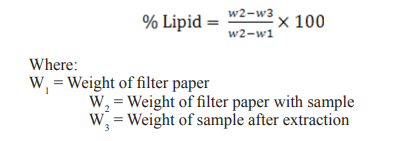
The ash content was determined by ashing the sample. Crucibles will be prepared, oven-dried for 30minutes, cooled in the desiccators for 30 minutes and weighed as weight one (W1). 1g of the sample into clean dried pre-weighed crucible with lid (W1). The crucibles were then be transferred into the muffle furnace set at 550°C (lid removed). Ashing was continued until a light grey of white ash was obtained. The crucibles were then cooled in desiccators and weighed (W3).

Exactly 2g (W1 ) of the sample were weighed into 1 litre conical flask and 200ml of 1.25% of H2SO4 (at boiling point) was added and boiled gently for 30 minutes. The mixture was filtered through muslin cloth and rinsed well with hot distilled water. The sample was scraped back into the flask with spatula and 200ml of 1.25% NaOH (boiling) was added and allowed to boil gently again for 30 minutes. It was filtered through muslin cloth and the residue washed thoroughly with hot distilled water and then rinsed ones with 10% HCl. This was rinsed again twice with ethanol and allowed to dry. Then residue was scrapped into a crucible, oven dried at 105°C, cooled in the desiccators and weighed (W 2). The residue was ashed at 550°C for 90 minutes in a muffle furnace, cooled and weighed again (W3).

NFE was computed by taking the sum of values for crude protein, crude lipid, crude fiber and moisture and subtracting this from 100 [21]. The remainder value was given the carbohydrate content of the sample. All analyses followed the procedures of AOAC [20]. % Carbohydrate = (% moisture + % ash + % fat + % protein + % fibre).
Initial mean weight of the fish was determined using sensitive
weighing balance after which regular sampling for mean weight
changes were taken at two weeks intervals for 8 weeks.
The data collected was processed for growth assessment and
nutrient utilization using the following formulae by Jobling [22].
The weight gains of fish in each treatment group were taken. All fish per treatment were individually weighed on a sensitive weighing balance and the respective means were recorded.
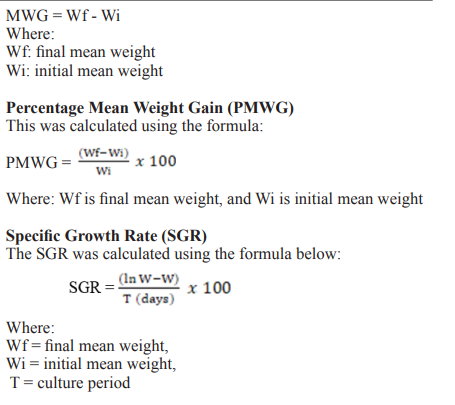
This was determined by the difference in weight between the feed
supplied and left over
FI = W0- W1;
Where:
W0 = The weight of feed supplied
W1 = The left-over feed
This is the amount of unit weight of food that the fish were able to convert into unit muscle.

Data obtained was analyzed using R console software version 3.6.1. Descriptive statistics was used to express the proximate parameters output. One-way analysis of variance was used to compare mean weight gain of Clarias gariepinus in relation to varying percentages of watermelon seed inclusion in fish meal. The level of significance was set at P < 0.05.
The proximate analysis of the experimental feed showed that DT3 (20.00%) had the highest crude protein content of 32.38% followed by DT2 31.79%, while DT1 (0%) had the lowest crude protein of 29.44% (Table 3).
The DT1 (control) had the highest dry matter with 95.43±0.03% followed by DT5 had 93.77±0.03b, then DT4 93.74±0.03c, DT2 93.65±0.03d while the DT3 (20%) had the least dry matter 93.46±0.03 (Table 3).
Lipid was highest in DT4 3.36±2.20a followed by DT3 3.32±2.20b then DT5 3.30±2.20c, DT2 3.20±2.20d while the least was DT1 2.36±2.20e (Table 3).
The ash content was determined by ashing the sample in which DT1 recorded 5.12±0.14a, DT2 4.12±0.14b, DT3 3.80±0.14e, DT4 4.08±0.14c and DT5 5.04±0.14d. DT1 had the highest while DT4 was the lowest (Table 3).
DT1 had the highest NFE 75.48±0.26a, followed DT5 75.38±0.25b then DT4 75.21±0.25c, DT2 74.35±0.25d and the least was DT3 73.76±0.25e.
Fibre was highest in DT1 56.54±0.01a followed by DT2 54.21±0.01b then DT4 46.51±0.01c, DT5 46.48±0.01d while the least fibre content was DT3 38.54±0.01e.
The Percentage Mean Weight Gain and Specific Growth Rate of Clarias Gariepinus Fed with Watermelon Seed MealThe mean weight gain by Clarias gariepinus was highest in the DT5 (36% watermelon seed inclusion) and least in the standard meal (0% inclusion). However, there was no significant difference (F70 = 1.311, adjusted R2 = 0.01655, P = 0.2743) in the mean weight gain by Clarias gariepinus in relation to varying percentages of watermelon seed inclusion as shown in Figure 1
The specific growth rate also showed that there was no difference between DT2, DT3, DT4, DT5 but were significantly different from DT1 (Figure 2).
The result in Figures 3 and 4 shows the feed intake and the feed conversion ratio of Clarias gariepinus fingerlings fed with watermelon seed cake. The result of the feed intake shows there was no significant difference (P > 0.05) in the intake of feed in DT1 and DT2 as well as between DT3, DT4, and DT5.
Table 3: Proximate Composition of Experimental Diets| Parameters (%) | DT1 | DT2 | DT3 | DT4 | DT5 |
|---|---|---|---|---|---|
| Dry matter | 95.43±0.03a | 93.65±0.03d | 93.46±0.03e | 93.74±0.03c | 93.77±0.03b |
| Crude Protein | 29.44±0.52e | 31.79±0.52c | 32.38±0.52a | 31.70±0.52b | 31.42±0.52b |
| Lipid | 2.36±2.20e | 3.20±2.20d | 3.32±2.20b | 3.36±2.20a | 3.30±2.20c |
| Ash | 2.67±0.02e | 4.73±0.02d | 4.81±0.02a | 4.81±0.02a | 4.82±0.02c |
| Moisture | 5.12±0.14a | 4.12±0.14b | 3.80±0.14e | 4.08±0.14c | 4.04±0.14d |
| NFE | 75.48±0.26a | 74.35±0.25d | 73.76±0.25e | 75.21±0.25c | 75.38±0.25b |
| Fibre | 56.64±0.01a | 54.21±0.01b | 38.54±0.01e | 46.51±0.01c | 46.48±0.01d |
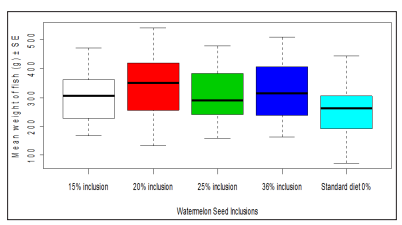
Figure 1: Mean Weight Gain of Clarias gariepinus Fingerlings Fed with Varrying Percentages of Watermelon Seed Inclusion in Fish Mea
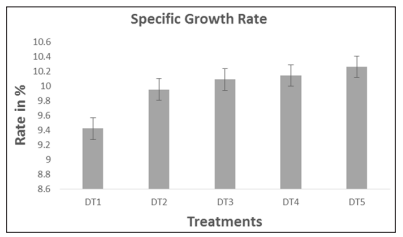
Figure 2: Specific Growth Rate of Clarias gariepinus Fingerlins Fed with Watermelon Seed Meal
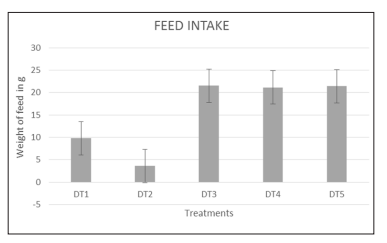
Figure 3: The Feed Intake of Clarias gariepinus Fingerlins Fed with Watermelon Seed Cake
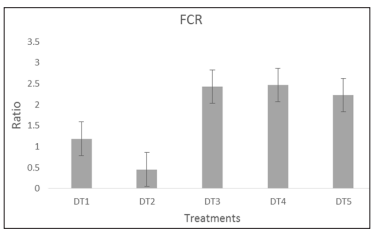
Figure 4: Feed Conversion Ratio of Clarias gariepinus Fingerlings Fed with Watermelon Seed Cake
Output obtained shows that the experimental feed has higher values of crude protein, lipid and ash. This could be attributed to the release of volatile materials in the watermelon seedcake which led to the concentration of the high protein, lipid and ash and reduction in dry matter, moisture and fibre. This finding agrees with that of Samia et al. [23] who reported watermelon seed cake having higher crude protein (32.68±32) lipid (14.05±12), crude fibre (3.75±0.09), ash (3.75±11) and carbohydrate (17.62±02). Also, our finding is in agreement with Fagbenro et al. [24] who reported reduction of crude protein (27.48%), lipid (3.80%), ash (5.50%), and nitrogen free extract (16.45%) compared to raw pumpkin seeds. Braide et al. [25] made similar findings on the lack of thermal application on water melon seeds. The moisture content of the watermelon cake reduced substantially from raw water melon seeds which suggest better keeping quality of the feed which may be associated to the gradual removal of moisture by heat. The value was highest in raw watermelon seeds and this might be due to lack of thermal treatment. Segun [26] validated the correlation of proximate chemical composition of flesh of important commercial fishes.
The proximate analysis of the experimental feed showed that the lipids extraction across treatments. This agrees with Sink and Lochmann [27] who stated that the lipids requirement of farmed catfish has been studied by a number of authors with varying results. This requirement depends on lipids source and quality and the protein content of the experimental diets. The lipid concentration is 28-30 percent protein diets ranges from 4 to 7 percent, about 3 to 4 percent of which is generally inherent in the feed ingredient.
The proximate analysis of the experimental feed showed that DT3 (20.00%) had the highest crude protein content of 32.38% followed by DT2 (31.79%), while DT1 (0%) had the lowest crude protein of 29.44%. This agrees with Wilson [28] who stated that most herbivorous and ominivorous fish evaluated until date require a diet with 25 to 35 percent crude protein , thus commercial feeds are carefully formulated to ensure that protein and amino acid requirement are met.
The ash content recorded in this study was between 3.80-5.12%. This agrees with Halver [29] who stated that fish usually have an ash level of 4-8% due to the fish meal in the diets (e.g calcium and phosphor). Feed with high fish meal level have high ash level.
Fibre, moisture content, dry matter and nitrogen free extract fell within range in comparison with the standard for fish nutritional requirements and agrees with Fasari who stated nutritional requirement and standards is put in place appropriately during formulation of feeds [30].
The result of this study indicated that there was no weight loss in the present study compared to the weight at the initial, observation on growth and nutrient utilization reveals that growth significantly increased as watermelon seed cake is increased in the diets. However, differences in performance of the experimental fish may be linked to superiority of protein quality of groundnut cake which reduced as level of replacement increases. DT5 (36%) watermelon seed cake significantly increased the growth of the fish with regards to final weight, weight gain and specific growth rate, compared to other diet treatments and the control. This may be due to the availability of nutrients and sufficient energy needed for metabolic activities and growth. DT4 has also shown great improvement in growth compared to the control. This does not agree with Haslim et al. who observed that growth significantly reduce as watermelon meal is increased in the diet [31].
Characteristic feed utilization efficiencies and the resultant growth rates has earlier been reported and attributed to dietary protein quality by Sotolu and Faturoti who reported that antinutritional factor in raw watermelon seed may also be the cause of significant reduction in growth [9]. Many other authors have similarly reported varied replacement level of about 50 %, 60% and 100% (Tiamiyu) of waste and by-products with conventional once [32-35]. It can be correctly inferred then that replacement of convention feeds by alternate sources of plant and animal origin, depends on the nature and composition of the unconventional.
The feed conversion ratio showed that Clarias gariepinus fingerlings fed best at 25% (DT4) due to feed conversion ratio of 2.6. This disagrees with Iheanacho who stated fingerlings gives better feed conversion with 100% inclusion of Citrullus lanatus watermelon [36].
In conclusion, inclusion of higher proportion (36%) of watermelon seed in fish feed will yield better growth performance of Clarias gariepinus. Therefore, fish farmers should embrace this inclusive diet to aid in high nutritional output and at the long run support food security.
